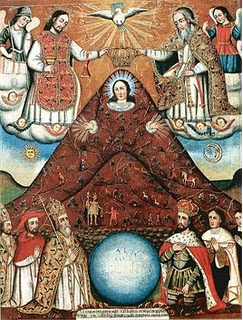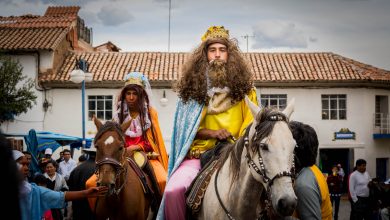Andean Syncretism

We consider syncretism to be the union of traits of two cultures, in this case Inca and colonial. At first Cisco’s natives had gods of nature, such as lightning, thunder, lightning, pachamama, sun, water, moon, etc. With the arrival of the Spaniards these began to be assimilated to the presence of a Christian God. This does not mean that they completely forgot the veneration of their own deities, however.

When the Spaniards arrived in the city of Cusco, they founded a school of religious painting in the XI century called: the Cusco School, in which Indians were taught the different techniques of fine art. This is why most of the paintings are anonymous. The Indians did not have writing. In these paintings the Indians always tried to place their own elements. For example if we talk about the images of the Virgin Mary,, we can appreciate that the face is a white complexion with European features, but the curious thing is that these virgins always have the body with the clothes in the form of mountain since the mountains in the Inca era were considered important deities. According to oral tradition, when an Inca, a ruler, died, the mountains maintained their spirit. For this reason people offered them sacrifices and offerings. Later, when the Indians took the Virgin in procession, internally they were worshiping their own deity, the mountains. In the same way, in the churches we can appreciate around the altars of saints and Virgins, the presence of mirrors, which in the Andean world represented the Qocha (the lakes). We can also see the most famous painting that is inside the Cathedral of Cusco, “The Last Supper of Jesus “, A painting in which Jesus is seen with his apostles and on the table is observed the Andean cuy, papaya, chicha made from purple corn, all of which are elements typical of the Andean world.
When the Spaniards realized that the mountains were sacred deities for the natives, they placed a cross on them as a form of imposition of the Catholic faith on the Andean religion, crosses that until the present we can observe it in some mountains of Cusco .
Until now there are several communities that live in the high parts of the mountains whose inhabitants maintain many traditions and customs of the Inca period. Such is the case for example: that they only speak Quechua. They do not use money for their transactions but practice barter (exchange of products). They still use their traditional clothes not only in festivities but daily. On Sundays they descend very early from the mountains towards the village, where they celebrate a mass in Quechua.
Until today in the south of Peru the people maintain a strong syncretism. In each one of the two cultures, the two religions are maintained. For example, when I enter a church I take off my hat and I cross myself in the name the father, the son and the holy spirit. That is Catholic religion. When I am in my house and I am about to have a drink, without thinking, I sprinkle a little of this drink at the Pacha Mama, mother earth. In doing this act , I am asking permission from mother earth to drink and that is Andean religion. In conclusion, we unconsciously practice the two religions; when we are Catholics we go to mass but in the month of August we make our offering, our payment, to the Pachamama to practice our reciprocity with our mother earth.

So many years have passed and in spite of everything that the Spaniards did to evangelize us and destroy our beliefs, we still maintain many traditions of the Andean world and hope that it continues so we maintain our identity.




